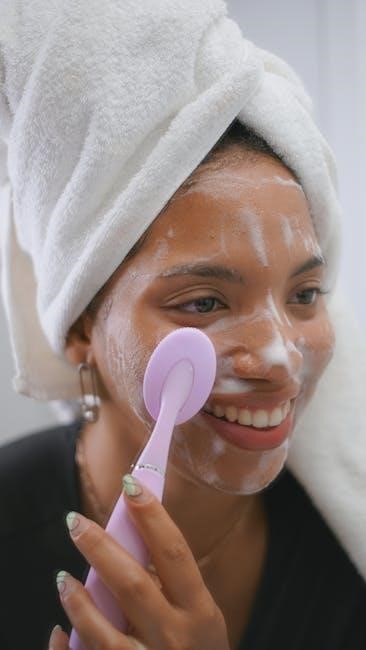Guided self-pleasure is a mindful, intentional practice that combines self-discovery with emotional and physical exploration, fostering empowerment and well-being through structured techniques and personal connection.
What is Guided Self Pleasure?
Guided self-pleasure is a structured and intentional practice that combines mindfulness, breathwork, and physical exploration to enhance intimacy with oneself. It involves following guided techniques or exercises to foster self-awareness, emotional connection, and personal growth. This practice goes beyond physical gratification, emphasizing self-discovery and empowerment through deliberate, conscious engagement with one’s body and emotions. It is a holistic approach to understanding and nurturing one’s sexual and emotional well-being.
The Importance of Self-Exploration in Sexual Health
Self-exploration is vital for understanding personal preferences, boundaries, and sexual responses, fostering empowerment and intimacy. It enhances emotional well-being by reducing stigma and promoting self-acceptance. Through guided practices, individuals gain clarity about their desires, improving communication in relationships. This mindful approach to sexual health encourages a deeper connection with oneself, leading to healthier, more fulfilling experiences and a positive body image. Regular self-exploration also supports mental and physical well-being.
Benefits of Guided Self Pleasure
Guided self-pleasure enhances emotional well-being, reduces stress, and boosts confidence, offering a deeper understanding of personal desires and improving intimacy in relationships through mindful exploration.
Emotional and Mental Well-Being
Guided self-pleasure promotes emotional balance by reducing stress and anxiety, fostering a deeper connection with oneself. It encourages mindfulness, allowing individuals to explore their feelings and desires in a safe, intimate setting. Regular practice can enhance self-esteem, improve mood, and create a sense of empowerment. By prioritizing personal well-being, it cultivates a positive self-image and emotional resilience, contributing to overall mental health and happiness.
Guided self-pleasure offers numerous physical health benefits, including improved circulation and reduced muscle tension. It can alleviate menstrual cramps and symptoms of menopause by releasing endorphins. Regular practice may enhance sleep quality, boost the immune system, and promote sexual health by maintaining genital vitality; These benefits contribute to overall well-being, making it a holistic practice for both body and mind, supported by scientific research and personal experiences. Guided self-pleasure fosters a deeper understanding of personal preferences and emotional responses, enhancing self-awareness. Through intentional exploration, individuals can connect with their bodies on a profound level, building confidence and intimacy. This practice encourages emotional connection, helping to identify personal boundaries and desires. By nurturing self-intimacy, it strengthens the ability to communicate needs in relationships, promoting healthier and more fulfilling connections with oneself and others. Guided self-pleasure involves structured techniques such as mindfulness, sensory exploration, and fantasy to enhance self-discovery and intimacy, fostering a deeper connection with oneself. Mindfulness and relaxation practices are essential for guided self-pleasure, helping individuals cultivate presence and reduce stress. Techniques like deep breathing, progressive muscle relaxation, and focused meditation create a calm environment for exploration. By centering the mind and body, these practices enhance sensory awareness, allowing for a deeper connection to personal sensations and desires. Regular mindfulness practice fosters self-discovery, emotional balance, and a more fulfilling experience. Sensory play is a key aspect of guided self-pleasure, involving the intentional engagement of the senses to enhance exploration. Techniques include experimenting with textures, temperatures, and visual stimuli to heighten sensitivity. Tools like silk, ice, or vibrational devices can create unique experiences, fostering curiosity and pleasure. By focusing on sensory responses, individuals can discover new sources of enjoyment, deepening their connection to their body and amplifying overall satisfaction. Fantasy and visualization are powerful tools in guided self-pleasure, allowing individuals to explore desires and create immersive experiences. By imagining scenarios, characters, or settings, one can deepen emotional engagement and amplify pleasure. These mental practices encourage openness and creativity, helping to break barriers and foster a deeper connection with oneself. Visualization also enhances mindfulness, making the experience more intentional and fulfilling, while fantasy provides a safe space to experiment and grow. Guided self-pleasure fosters a deeper emotional and psychological connection with oneself, promoting self-intimacy, confidence, and emotional well-being while reducing feelings of guilt or shame through mindful exploration. Guided self-pleasure can help individuals overcome guilt or shame by fostering self-acceptance and understanding. Many people experience guilt due to societal stigma, religious beliefs, or past experiences. Education and mindfulness practices can redefine self-pleasure as a natural, healthy act. By embracing self-compassion and challenging negative narratives, individuals can cultivate a positive relationship with their bodies and emotions, leading to greater confidence and emotional freedom. Guided self-pleasure fosters self-intimacy by encouraging individuals to explore and understand their bodies deeply. Through mindfulness and self-compassion, it helps build confidence by embracing personal desires and preferences. By prioritizing pleasure and comfort, individuals can develop a positive relationship with their bodies, reducing self-criticism and enhancing overall self-assurance. This practice empowers people to feel more connected to themselves, fostering emotional and physical confidence. Cultural and social perspectives on guided self-pleasure vary widely, reflecting societal norms, religious beliefs, and historical attitudes toward sexuality. Some cultures embrace it as natural, while others stigmatize it, influencing personal and collective experiences. Cultural attitudes toward self-pleasure range from acceptance to repression. In many Eastern cultures, it is seen as a natural practice for health and balance. In contrast, some Western societies have historically stigmatized it, often due to religious influences. Indigenous cultures may integrate it into rituals for spiritual connection. These diverse perspectives highlight how societal norms shape personal and collective views on self-pleasure, influencing individual experiences. Societal stigmas surrounding self-pleasure have historically led to shame and secrecy, often rooted in cultural and religious norms. However, modern attitudes are shifting, with increasing acceptance and openness. Education and media play a significant role in normalizing the practice, emphasizing its benefits for mental and physical health. While stigma persists in some communities, progressive conversations are fostering a more inclusive and understanding environment, encouraging individuals to embrace self-pleasure as a natural part of life. Explore books, online communities, and educational websites that offer detailed guides and support for self-pleasure practices, fostering a deeper understanding and connection with your body and desires. The Guide to Self Pleasure by a renowned pleasure teacher offers practical techniques and insights, while Pleasure: A Sexual Education by Dr. Emily Nagoski explores transforming your relationship with intimacy. These books provide expert advice, fostering self-discovery and empowerment. They are essential resources for anyone seeking to deepen their understanding and connection with their body. Explore these guides to enhance your journey of self-pleasure and intimacy. Online communities like Reddit’s r/Sexuality and r/SelfCare offer safe spaces for discussing guided self-pleasure. Forums such as Discord groups and specialized sex-positive platforms provide support, share techniques, and foster connection. These communities empower individuals to explore their intimacy freely, offering resources and personal stories. Engaging with these forums can enhance your journey, providing reassurance and practical advice. They are invaluable for those seeking guidance and camaraderie. Prioritize cleanliness, use appropriate lubrication, and respect personal boundaries to ensure a safe and hygienic experience, fostering physical and mental well-being. Common mistakes during solo exploration include rushing the process, neglecting lubrication, or ignoring comfort. Avoid using unsafe objects or applying excessive pressure, which can cause discomfort or harm. Refrain from over-reliance on devices without exploring natural sensations. Don’t dismiss emotional needs or skip hygiene practices. Prioritize self-awareness and gentleness to ensure a safe and fulfilling experience. Guided self-pleasure positively impacts mental health by reducing stress, improving mood, and enhancing self-esteem. It fosters self-awareness and mindfulness, promoting emotional balance and personal growth. Masturbation is linked to improved mental wellness by reducing stress and anxiety, promoting relaxation, and enhancing mood through endorphin release. It fosters self-awareness, self-acceptance, and emotional regulation, contributing to a healthier mental state. Regular practice can also improve sleep quality and boost confidence, creating a positive cycle of emotional and psychological well-being. This connection highlights the importance of masturbation as a tool for holistic mental health. If self-pleasure becomes compulsive, interferes with daily life, or causes emotional distress, it may be time to seek professional help. A therapist can address underlying issues like guilt, shame, or anxiety. If masturbation negatively impacts relationships or mental well-being, professional guidance can provide coping strategies and support. Seeking help is a proactive step toward balancing sexual health with emotional and psychological well-being. Guided self-pleasure is a powerful tool for empowerment, fostering emotional and physical well-being while encouraging intimacy and confidence. Embrace it as a natural, healthy aspect of life. As we conclude, remember that guided self-pleasure is a journey of self-discovery, empowerment, and connection. By embracing this practice, you can foster emotional and physical well-being, enhance intimacy, and build confidence. It’s a natural and healthy aspect of life that encourages mindfulness and personal growth. Approach it with curiosity and openness, allowing yourself to explore and learn in a safe and nurturing environment. This practice is not just about pleasure—it’s about understanding and loving yourself deeply. Embrace guided self-pleasure as a transformative journey of self-discovery and empowerment. By exploring your body and mind, you can deepen your understanding of your desires and needs, fostering a healthier relationship with yourself and others. Remember, this practice is a safe space for growth, learning, and acceptance. Take the time to experiment, be patient, and celebrate the unique experiences that arise from this intimate connection with yourself. Keep exploring, and let your journey be one of curiosity, joy, and self-love.Physical Health Benefits
Enhanced Self-Awareness and Intimacy

Techniques for Guided Self Pleasure
Mindfulness and Relaxation Practices

Exploring Sensory Play
The Role of Fantasy and Visualization

Emotional and Psychological Connection
Overcoming Guilt or Shame
Building Self-Intimacy and Confidence

Cultural and Social Perspectives
How Different Cultures View Self Pleasure
Societal Stigmas and Changing Attitudes
Resources for Guided Self Pleasure
Recommended Books and Guides
Online Communities and Forums
Safety and Hygiene Tips
Best Practices for Solo Exploration
Avoiding Common Mistakes

Mental Health and Self Pleasure
The Connection Between Masturbation and Mental Wellness
When to Seek Professional Help
Final Thoughts on Guided Self Pleasure
Encouragement for Further Exploration
